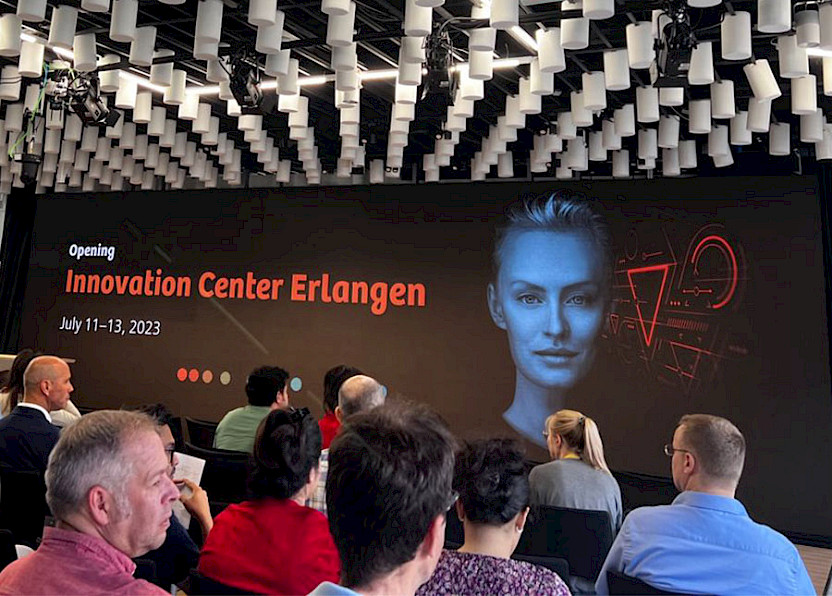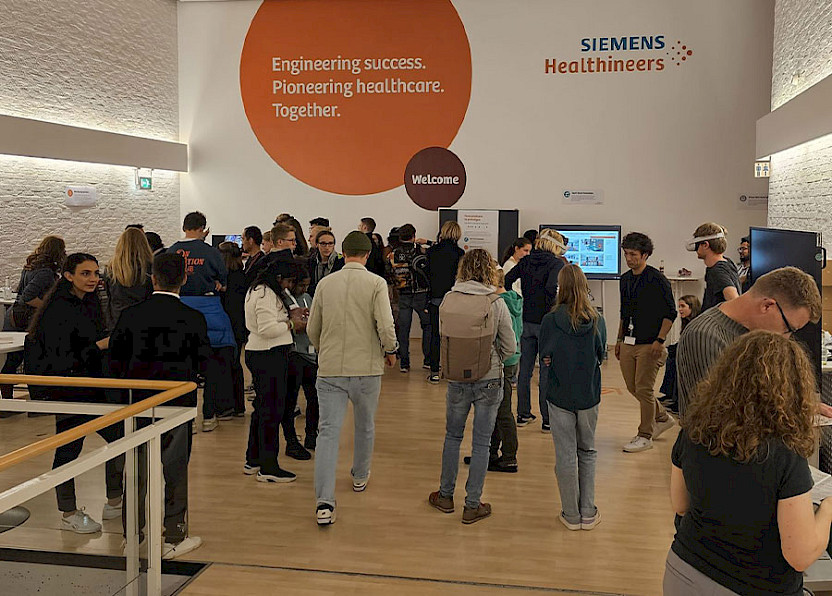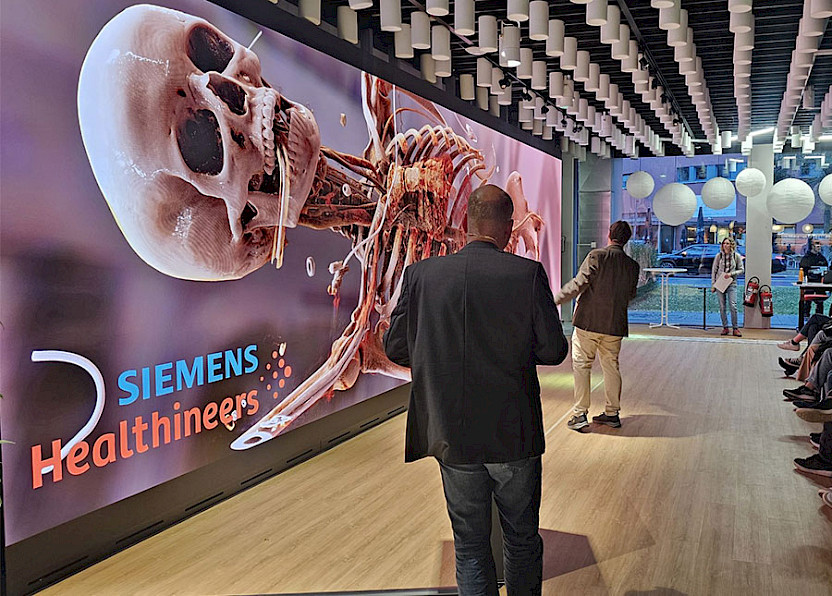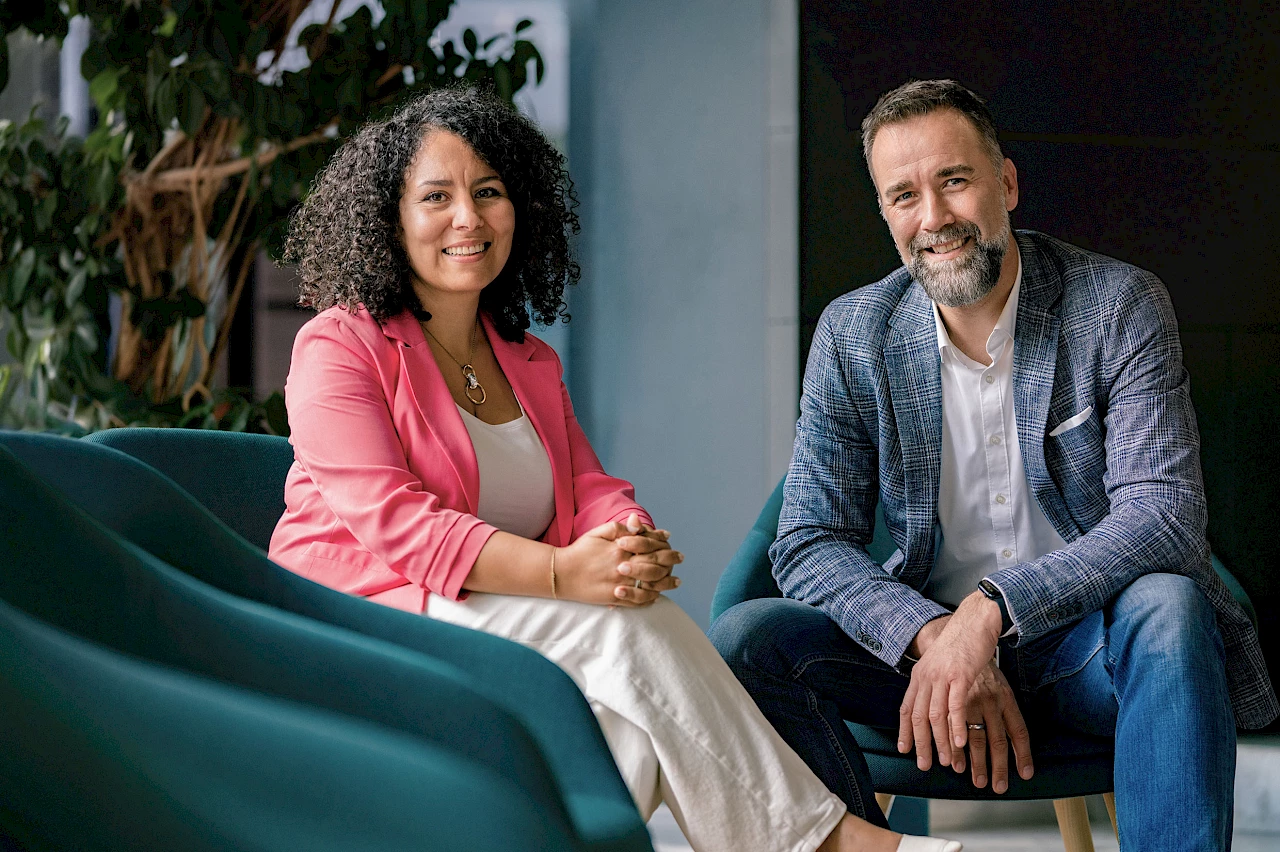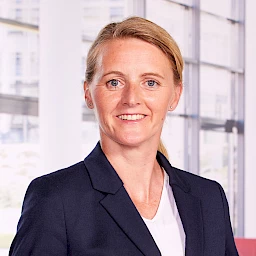The Siemens Healthineers Innovation Center in Erlangen was opened in July 2023. This has created an infrastructure that strengthens innovation-promoting activities across corporate boundaries. The editorial staff of the IBA Forum talked with Amira Romani, Senior Vice President of Global Innovation & Technology, and Peter Aulbach, Head of Innovation Center in Erlangen, about open innovation and its spatial requirements.
Ms Romani, you are Senior Vice President of Global Innovation & Technology at Siemens Healthineers, and last year you opened the Innovation Center in Erlangen. What goals are you pursuing through this facility? And what role have you assigned to the Innovation Center within the context of Siemens Healthineers worldwide?
Amira Romani: The Siemens Healthineers Innovation Center is part of our global innovation ecosystem. It’s a place where the spirit of open innovation can be directly experienced. At its centre is the company’s cooperation with external partner companies and startups as well as academic and clinical institutions. We regard our Innovation Centers as a group of dynamic networks or ecosystems that collaborate, learn from one another in the process and continue developing together. In line with the guiding principle “Think global, act local”, the Innovation Center in Erlangen supplements the existing network of the innovation locations in China and India in order to promote regional intercommunication and create added value for healthcare systems all over the world. We have an ecosystem that is globally networked but adapted to local conditions.
Peter Aulbach: As an accelerator and an incubator, the Innovation Center brings together colleagues from the Product Lifecycle Management department and from research and development with our most important collaboration customers in order to cooperatively develop new healthcare solutions. By means of the facilities of the Innovation Center and methods such as design thinking and co-creation, as well as digital platforms, we support our business units as they discover new products with added value – the gold mines of tomorrow, so to speak.
The Innovation Center is meant to be a place for open innovation. How do you define this concept in concrete terms?
Amira Romani: In my opinion, open innovation means that we are moving from a linear innovation pipeline toward a networked innovation process in which we are connected with one another. Every individual has the potential to be an innovator and to contribute innovative ideas. It’s basically all about understanding what the important problems are and what we have to offer as a solution. And in the next step, it’s all about matchmaking. This concept is implemented at the Innovation Center of Siemens Healthineers in the form of an open network and ecosystem where different actors, such as startups, established companies, governments, universities, foundations and syndicates can get together. Our work at the Innovation Center is strongly characterised by an open, networked approach that makes it possible to utilise the strengths and solutions of the various actors and cooperatively promote innovations. Our Innovation Centers are the beacons and the focal points of their respective regional markets.
Peter Aulbach: The idea underlying the Innovation Center is the creation of an infrastructure that strengthens shared regional innovation activities, promotes openness and cooperation in the areas of research, development and production, and makes it possible to develop innovations in a process oriented toward customers and markets. One example of that is digitalisation in the healthcare sector. The implementation of digital projects is still a huge challenge for many providers of healthcare services, because of its technical complexity as well as the human resources involved. At the Innovation Center we offer an interoperable platform, a place for various communities and modern co-working spaces. With the help of these features, new business models can be tried out here and tested safely in the clinical environment. We are a home base for cross-organisational partnerships and cooperation networks, and one of our aims is to actively help shape digital networking in the healthcare sector.
How do people join together in this process on a practical level? How do innovative ideas and creative solutions arise?
Amira Romani: In the innovation process, we adapt our approach to each specific topic, ecosystem and country. We’ve also created the SHIFT movement, an open innovation movement we call the “Golden Glue of Innovation”. An image I like to use is the kintsugi concept from Japan, in which broken pottery is not thrown away but repaired with gold. Through this process the object becomes more valuable than it was before. A similar process takes place through innovation in a major company with 70,000 employees such as ours. It’s all about using existing resources and ideas and refining them in order to enhance their value. Our work is based on the three pillars People, Places and Platform. Every individual can be an innovator and use our Innovation Centers as a set of open spaces for co-creation. Physical and virtual platforms enable people to share ideas and work together across the boundaries of companies and countries. To this end, we offer various formats such as hackathons and workshops, and we promote the use of tools and methods that support the innovation process. We basically regard ourselves as facilitators who create spaces and opportunities for creative processes so that we can work together to generate added value.
Peter Aulbach: At the Innovation Center attach great importance to filling the existing framework with life. The informal space around the coffee machine should not be underestimated, because it’s the starting point of many conversations that generate “aha” moments and creative impulses. Our approach is to create a meeting place where people who are facing different challenges and have different ideas can get together. We want to offer a platform that also provides space for unconventional ideas and topics that might not immediately attract attention in the business areas that already exist. As a result, we actively work to develop formats that bring together topic-specific groups, and we focus on a culture of communication and cooperation across company borders. For example, in the #InnovationXCamps the participants follow an agile development model, working in short sprints to form teams, evaluate ideas and technologies and share them with customers. In this way they generate synergies and innovative solutions that go beyond what already exists, so that one plus one can add up to three. At the moment we are growing very successfully in this area.
The challenge probably lies not only in creating the network but also in empowering people and bringing ideas together both physically and virtually. How can this be done successfully?
Peter Aulbach: Successfully bringing people and ideas together, both physically and virtually, is a continuous process. Thanks to the support we get from Amira and her insistence on an agile approach to management, at Siemens Healthineers we have adopted tried and tested methods such as Six Sigma Blackbelt and the Lean principles and integrated them into the way we work. One important aspect of that is the introduction of retrospectives, especially when we are entering uncharted territory. They enable us to reflect on the value of the steps we’re taking and to correct our course so that we can move forward more efficiently. During the pandemic in particular, the need for virtual cooperation was a crucial factor. Through intensive workshops and team meetings in various regions such as China, Bangalore and the USA, we gathered valuable experiences. One key experience was the realisation that virtual teams often had the feeling they were being overlooked or were not being fully integrated. To improve this situation, we implemented large displays for virtual meetings and a shared virtual concept board that enabled all the team members to participate on an equal footing, whether they were on site or online. One central aspect was the creation of eye-level participation both physically and virtually in order to ensure that all the team members were seen and heard equally well. This format proved to be extremely successful, and it shows that the continuous adjustment and improvement of our virtual cooperation is an important key to success.
Amira Romani: The open innovation process is complex, and it includes various milestones. We basically follow two main lines of action. The first one is internal. Working with the business units, we identify synergies that we want to cooperate on, and on this basis we develop themes that are relevant for many units. This common denominator serves as a link that we work on in a process of co-creation with all the participants in order to utilise synergies and create added value. The second line of action is customer-oriented. A structured analysis of the existing information is carried out within the system in order to identify and address the customers’ pain points. We have a traditional innovation process that aims to cooperatively address topics that are relevant for a variety of units and yield high customer benefits. It’s not a matter of isolated topics but of holistic approaches that are broad in scope. The challenge lies not only in expanding the network but also in empowering people and bringing ideas together effectively, both physically and virtually. This is achieved by means of clear processes and a collaborative environment where innovative ideas can emerge and be implemented.
Please also read

The ability to work in this way requires a certain kind of culture. How would you describe the work culture and the corporate culture at Siemens Healthineers?
Amira Romani: Innovation is the driving force of our activities, and creativity is the precondition for innovation. The work and corporate culture at Siemens Healthineers is characterised by an open, target-oriented and innovative atmosphere. With the help of our global innovation ecosystem SHIFT, we’re trying to bring the “hungry and foolish” spirit of young entrepreneurs into our company and to put it into practice. Our corporate values reflect this culture: we listen closely in order to understand where the challenges lie. We take on responsibility and seek openness, because we know that ultimately it’s all about our customers and their needs. Our goal is to make a difference, and we have expressed this in our statement of purpose: “We pioneer breakthroughs in healthcare. For everyone. Everywhere. Sustainably.” This corporate goal is deeply anchored in our DNA.
Peter Aulbach: The culture of Siemens Healthineers is oriented toward enabling exploration and innovation and creating a supportive and encouraging environment. We promote co-creation, design thinking and co-located working for people who recognise the potential of cross-innovation and want to utilise it. Our culture promotes cooperation and innovation not only between our teams but also with external communities. Here at the Innovation Center more than 30 different communities have found a home. They consist of people who are enthusiastic about topics related to technology or innovation above and beyond their daily work. We are proud of the fact that these communities regard our Innovation Center as their living room and that they meet here regularly in order to conduct workshops with customers, some of which they’ve organised themselves, as well as co-creation sessions and testing and validation sessions. One special example of that was the collaboration with several children to develop an app that would take away their fear of the knocking sound inside an MRT scanner. This initiative arose here at the Innovation Center in close cooperation with physicians. During this process, the space became a genuine playground. This is a case of openness in the best sense of the word.
What role is played by physical space? What’s the guiding architectural principle of the Innovation Center?
Amira Romani: The physical space plays a key role in the promotion of innovation and collaboration. Our Innovation Center started out as a restructured existing building. It initially elicited a degree of scepticism as to whether a special space for innovation was needed at all. It’s a place where people like to gather, whether it’s for planned events or spontaneous meetings. We set great store by an aesthetically attractive design with lots of glass, warm wood tones and dynamic colours in order to create an inspiring atmosphere. In spite of the pleasant surroundings, people do serious work here, supported by the right equipment and conveniences such as a high-quality coffee machine, all of which create an atmosphere of hospitality and well-being.
How diverse is the range of spaces in the Innovation Center, and were the employees included in the development process?
Amira Romani: We consider empowerment and diversity very important. That’s why we introduced a wide range of benchmarks and conducted discussions in which we asked our colleagues about their needs. In addition, through dialogues with the real estate team and other stakeholders we collected a wide variety of inspiring ideas from our ecosystem that flowed into the development of the spatial concept. One important step was to directly ask the communities so that we could understand what they consider important. Their responses resulted in the idea of creating a place where they could meet and work on their projects in a concentrated way. Other communities needed a space for events or the biggest screen we’ve ever had. We tried to fulfil most of these needs to the best of our ability, and we did this using a modular approach. For example, the arena in which we are right now can be used as a venue for town hall meetings, a children’s playground, a trade fair venue or for other formats.
Peter Aulbach: At the Innovation Center we’ve created a varied range of spaces that can be used flexibly. We offer opportunities to stage exhibitions, meetings and celebrations of successful innovations. True to our motto, we offer the ultimate in flexibility. We are working to create opportunities for innovations and to offer different formats such as the X Camp and the Innovation X Days in order to promote new ideas and share existing know-how. We’re especially proud of our successes in the area of digital innovation. That’s because data don’t provide much added value if they are not connected with a high-performance technology. Right now we’re working on a digital patient twin and on utilising the potential of medical data. We’ve created a digital sandbox for customers and developers where they can evaluate and test various scenarios.
How has collaboration changed since the opening of the Innovation Center?
Amira Romani: We’ve noticed that disruptive innovations often emerge at the interfaces between different areas. The Innovation Center helps to break down barriers. Ever since it opened, we’ve seen the development of many communities that have implemented projects successfully. One example is the project with Wingcopter, a startup in the area of drone delivery, to transport blood samples in Africa. This kind of collaboration helps to form “innovation glue”, a new kind of value creation that enables people all over the world to have a better access to healthcare.
Peter Aulbach: Our mission is to bring about a massive cultural change. It involves collecting our employees where they are right now, and making it easy for them to try out new ways of doing things in order to be successful. We cooperate closely with pioneers who are ready to get involved in this transformation. Examples of success then serve as role models for others. We regard ourselves as an integrator, catalyst and incubator for innovations, and for this we use the methods and tools of the Innovation Center. This is what drives us, and it’s the core of who we want to be.
How do communities come together within the Innovation Center?
Amira Romani: There are many approaches to forming communities here. One such is the Key Expert Communities, which consist of experts and thought leaders who are brought together deliberately. But there are also communities that form through self-organisation. The Large Language Modelling Community, which formed because of people’s interest in topics such as ChatGPT, is one example. Two colleagues had the idea of conducting a discussion within a community, and this idea grew into a group of more than 400 members that is active all over the world. In my opinion, that’s an example of the active life of open innovation, and also of kintsugi.
Ms Romani, Mr Aulbach, thank you for talking with us.
